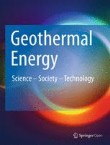Associated Societies
Monitoring of a reverse cement job in a high-temperature geothermal environment
Cementing operations in wellbores, especially for long casings, are often challenging and prone to deficiencies when not properly planned and executed. While exploring for and exploiting of geothermal resource...
